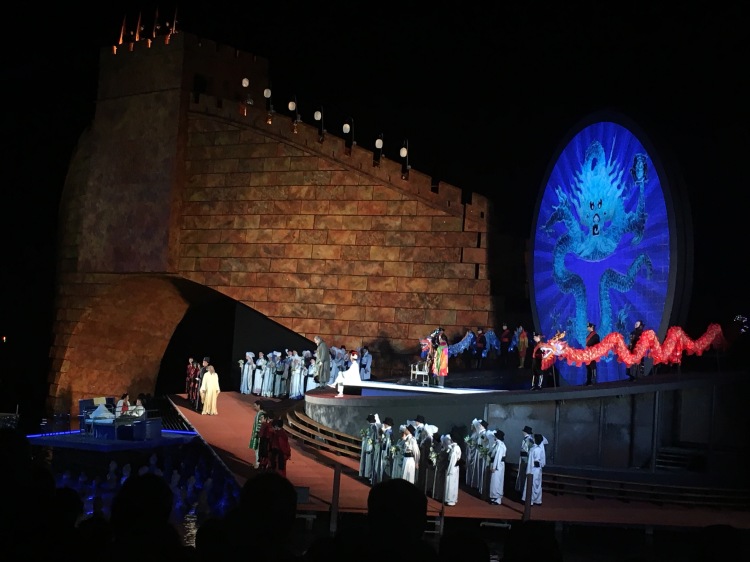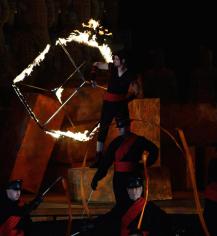The evening started with a breathtaking sunset over Bodensee, and hundreds of people going along seaside Promenade towards lake stage were stopping and taking photos of the lake and ships arriving with spectators. The weather was perfect, cooling down after the hot day, no rain expected, so everything promised perfect evening.

The lake stage itself is a marvel of engineering, providing space for artists and technical support staff, with a peculiar arrangement for orchestra and chorus to deliver performance from inside Festspielhaus, thus minor rain is not disrupting performance, except if only creating inconvenience to the members of the audience. The effect of rain I have observed on next evening, when dining at a nearby restaurant, unexpected shower surprised and performance was stopped for some 10 minutes to wait it subside.

The production has everything in abundance, though the story sometimes vanished behind the circus of martial arts, military, terracotta soldiers and over encompassing LED screen rotating above heads of main protagonists.

Bregenzer Festspiele/ Karl Forster

There were so many different themes and overlapping concepts, that main idea, propagated by Marco Arturo Marelli as director and designer of scenography is unluckily diluted by too much of side characters and activity. While I was trying to absorb a meaning of differently lit up terracotta army of 200, there were acrobats and mimes running on the stage, then kungfu masters demonstrated their perfect muscles, and in a moment the crowd of people dressed like in another era flooded the stage. In between you see Calaf dressed up in contemporary clothes, while Liu, Timur, the Emperor and Turandot are consistently kept in period outfits.
The centrepiece of the stage is rotating cylinder, which is a piece of art itself, as it contains sets for several scenes and a huge LED screen in a diameter over 10 meters, which is rotating itself and moves together with rotating cylinder. Impressive element, probably a bit overused.
Appearance of Ping, Pang, Pong in their “library” is smart and livens up usually a bit boring scene. Very strange element is typical simple bedroom located at the front. Well thought out concept of Chinese people – even if not played by chorus members, impressive and justified approach.
Quoting Bregenz Festival webpage info: “On the Bregenz stage it’s delivered against the imposing backdrop of a dragon-shaped wall on Lake Constance. Marco Arturo Marelli’s stage set makes use of Chinese symbols of power. The stage wall is inspired by the world’s longest man-made structure, the Great Wall of China. The Bregenz wall is crisscrossed by detachments of terracotta warriors, over two hundred in all, some of them sky-high, others half-submerged in the water.”
The wall also contains embedded loudspeakers, and this leads to main dissappointment of the night. I might be opinionated in the matter of amplified opera performances, even if they are staged and performed outdoors. It also could be the impact of relatively inexpensive seat chosen being located away from the centre of the stage nevertheless, the sound coming from inside Festspielhaus from the orchestra and the chorus was balanced and well heard while main soloists performing from the stage with microphones had issues both on volume and synchronisation. This created a feeling of listening to two separate tracks and during intermezzos it was a pure pleasure to listen to the pleasant sound of the orchestra under enthusiastic and precise direction of Paolo Carignani. For those interested in backstage activities, there are several screens on sides and back projecting the conductor as well as members of the orchestra and the chorus during and after the performance. This becomes entertaining when curtain call coordinator appears on the screen with instruction to synchronise cast bows on the stage – take a look back at the top of the Festspielhaus itself!
The singers were doing their best, I was repeatedly impressed by the performance of Mika Kares, that night as Timur, his vibrant bass sounds convincingly and portrays Timur as just blindness incapacitated regal rather than elderly man relying on help of his servant.
Katrin Kapplusch created a multifaceted character of disturbed princess painting her transformation from fear and hatred to love, giving her best both vocally and dramatically.
Arnold Rawls as Calaf was less convincing, the volume was there, but nuances and pianissimi through understanding emotion was missing. As per Operabase, he is a veteran in Bregenz Festival, and Calaf as well as Radames are the roles in his permanent repertoire.
Yitian Luan was able to create very believable Liu, her interpretation depicted both fragility, emotionality and dedication.The audience greeted her enthusiastically during curtain calls.
Suggestion on seat choice for this particular performance – better to chose left side of the stage since most of the action is facing that direction. Right side will let you be the first to see what is under rotating centrepiece for next scene. If you can afford middle sectors and rows above 10, it will be perfect seating to enjoy the show!
Overall satisfied that I came, and even if Verona does the same 6 shows for years, and grandeur of sets has been worn a bit over time and the place has become too touristic and commercial, I would prefer to see Turandot again there. Or – maybe even better be it Orange? Mostly because opera is about synergy among all those components, but sound and singing is the core of it..

Turandot finale. Bregenzer Festspiele, Karl Foster

Turandot finale. Bregenzer Festspiele, Karl Foster
“Turandot” by Giacomo Puccini
Lyric drama in three acts and five scenes (1926) | Libretto by Giuseppe Adami and Renato Simoni | Closing duet and finale completed by Franco Alfano | Sung in Italian with German surtitles
Conductor Paolo Carignani
Stage director & stage designer Marco Arturo Marelli
Costume designer Constance Hoffman
Lighting designer Davy Cunningham
Video designer Aron Kitzig
Sound designer Gernot Gögele | Alwin Bösch
Choral director Lukás Vasilek | Benjamin Lack
Fight choreographer Ran Arthur Braun
Dramaturg Olaf A. Schmitt
Turandot Katrin Kapplusch
Altoum Manuel von Senden
Timur Mika Kares
The unknown Prince (Calaf) Arnold Rawls
Liù Yitian Luan
Ping Mattia Olivieri
Pang Peter Marsh
Pong Martin Fournier
A Mandarin Grigory Shkarupa
Acrobats | Fire artists | Extras
Bregenz Festival Chorus
Prague Philharmonic Choir
Children’s choir of Musikmittelschule Bregenz-Stadt
Stage music in cooperation with Vorarlberg Conservatory
Vienna Symphony Orchestra

















